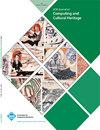基于内容相似性的空间适应性艺术品放置——虚拟博物馆主题空间策展
IF 2.2
3区 计算机科学
Q3 COMPUTER SCIENCE, INTERDISCIPLINARY APPLICATIONS
引用次数: 0
摘要
虚拟现实(VR)为策展人提供了设计沉浸式3D展览空间的工具。然而,在VR中手动定位艺术品是一项劳动密集型的工作,现有的大多数自动化方法在考虑艺术品内容和空间特征以及适应策展人的设计偏好方面受到限制。为了应对这些挑战,我们提出了一个虚拟展览创作系统,该系统可以自动为主题空间布局生成优化的艺术品放置位置,其中展品按概念主题分组并排列成集群。我们的方法基于五个内容相似因素——颜色、材料、描述、艺术家和制作日期——对艺术品进行分类,并允许策展人调整每个因素的重要性,并根据他们的设计目标设置分类大小的限制。采用遗传优化算法来确定艺术品的放置位置,使用四个成本函数-簇内距离,簇间距离,簇内可见性和占用率-来评估空间特征方面的安排。我们的方法的有效性是通过一系列的实际情况和专家评估与策展人证明。本文章由计算机程序翻译,如有差异,请以英文原文为准。
Space-Adaptive Artwork Placement Based on Content Similarities for Curating Thematic Spaces in a Virtual Museum
Virtual Reality (VR) provides curators with the tools to design immersive 3D exhibition spaces. However, manually positioning artworks in VR is labor-intensive, and most existing automated methods are limited in considering both artwork content and spatial characteristics, as well as accommodating curators’ design preferences. To address these challenges, we present a virtual exhibition authoring system that automatically generates optimized artwork placements for thematic space layouts, where exhibits are grouped by conceptual themes and arranged as clusters. Our approach clusters artworks based on five content similarity factors—color, material, description, artist, and production date—and allows curators to adjust the importance of each factor and set limits on cluster sizes according to their design goals. A genetic optimization algorithm is employed to determine the placement of artworks, using four cost functions—intra-cluster distance, inter-cluster distance, intra-cluster intervisibility, and occupancy—to evaluate the arrangement with respect to spatial characteristics. The effectiveness of our approach is demonstrated through a series of practical scenarios and an expert evaluation with curators.
求助全文
通过发布文献求助,成功后即可免费获取论文全文。
去求助
来源期刊

ACM Journal on Computing and Cultural Heritage
Arts and Humanities-Conservation
CiteScore
4.60
自引率
8.30%
发文量
90
期刊介绍:
ACM Journal on Computing and Cultural Heritage (JOCCH) publishes papers of significant and lasting value in all areas relating to the use of information and communication technologies (ICT) in support of Cultural Heritage. The journal encourages the submission of manuscripts that demonstrate innovative use of technology for the discovery, analysis, interpretation and presentation of cultural material, as well as manuscripts that illustrate applications in the Cultural Heritage sector that challenge the computational technologies and suggest new research opportunities in computer science.
 求助内容:
求助内容: 应助结果提醒方式:
应助结果提醒方式:


